-
 Artist: Utagawa Kunimaru [歌川国丸] (Japanese, 1794 – 1829). Publisher: Ibaya Senzaburō [伊場屋 仙三郎] (fl. 1815 – 1869). Date-kiwame seal: Bunsei 10 (1827). Signed: Ichiensai Kunimaru ga [一円斎国丸画]. Play: Chūshingura [忠臣蔵] (The Treasury of Loyal Retainers), 11th act, Night Battle [十一段目夜討之図]. Act XI: The Attack on Kō no Moronao Mansion. Kō no Moronao [高 師直] (Japanese, d. 1351). Ref: Ako City Museum of History Inscription on the soba peddler box: Nihachi soba udon [二八そば うどん] – twice eight soba and udon (16 mon per serving).
Artist: Utagawa Kunimaru [歌川国丸] (Japanese, 1794 – 1829). Publisher: Ibaya Senzaburō [伊場屋 仙三郎] (fl. 1815 – 1869). Date-kiwame seal: Bunsei 10 (1827). Signed: Ichiensai Kunimaru ga [一円斎国丸画]. Play: Chūshingura [忠臣蔵] (The Treasury of Loyal Retainers), 11th act, Night Battle [十一段目夜討之図]. Act XI: The Attack on Kō no Moronao Mansion. Kō no Moronao [高 師直] (Japanese, d. 1351). Ref: Ako City Museum of History Inscription on the soba peddler box: Nihachi soba udon [二八そば うどん] – twice eight soba and udon (16 mon per serving). -
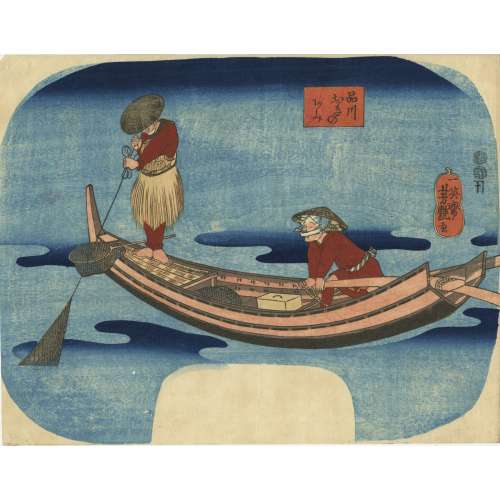 Artist: Utagawa Yoshitsuya [歌川 芳艶] (Japanese, 1822 – 1866). Publisher: Kojimaya Jūbei [小島屋重兵衛] (Japanese, c. 1797 – 1869). Date seal and double nanushi censor seals: Kunigasa & Yoshimura, Kōka 5 (1849). Signed: Ichieisai Yoshitsuya ga [英斎芳艶画] in a red double gourd cartouche. Two men are fishing with a net off the coast of Shinagawa, in the Edo Bay.
Artist: Utagawa Yoshitsuya [歌川 芳艶] (Japanese, 1822 – 1866). Publisher: Kojimaya Jūbei [小島屋重兵衛] (Japanese, c. 1797 – 1869). Date seal and double nanushi censor seals: Kunigasa & Yoshimura, Kōka 5 (1849). Signed: Ichieisai Yoshitsuya ga [英斎芳艶画] in a red double gourd cartouche. Two men are fishing with a net off the coast of Shinagawa, in the Edo Bay. -
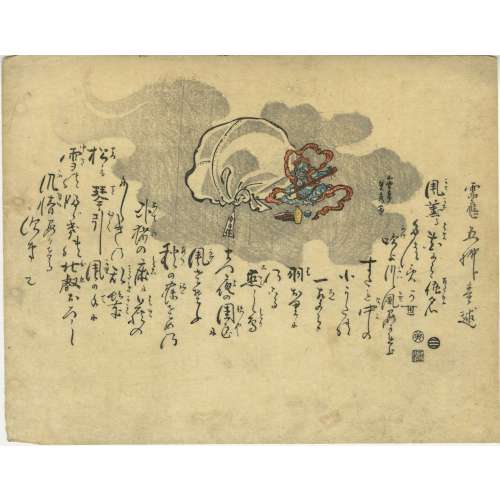 Artist: Utagawa Sadahide [歌川 貞秀] (Japanese, 1807 – c. 1878-9). Publisher: Ibaya Senzaburō [伊場屋仙三郎] (Japanese, c. 1815 – 1869). Date-kiwame seal: 1831 (Tenpō 2). Size: Uchiwa-e, 298 x 232 mm. Signed: 五雲亭 貞秀 (Gountei Sadahide) A pair of uncut fan prints with the god of wind and the god of thunder meant to be pasted on two sides of a uchiwa fan. This is an allusion to the famous painting Wind God & Thunder God [Fujin Raijin, 風神雷神図] by Ogata Korin [尾形光琳] (1658 - 1716).
Artist: Utagawa Sadahide [歌川 貞秀] (Japanese, 1807 – c. 1878-9). Publisher: Ibaya Senzaburō [伊場屋仙三郎] (Japanese, c. 1815 – 1869). Date-kiwame seal: 1831 (Tenpō 2). Size: Uchiwa-e, 298 x 232 mm. Signed: 五雲亭 貞秀 (Gountei Sadahide) A pair of uncut fan prints with the god of wind and the god of thunder meant to be pasted on two sides of a uchiwa fan. This is an allusion to the famous painting Wind God & Thunder God [Fujin Raijin, 風神雷神図] by Ogata Korin [尾形光琳] (1658 - 1716). And the earlier versions of the same by Tawaraya Sotatsu [俵屋宗達] (1570-1643).
And the earlier versions of the same by Tawaraya Sotatsu [俵屋宗達] (1570-1643).
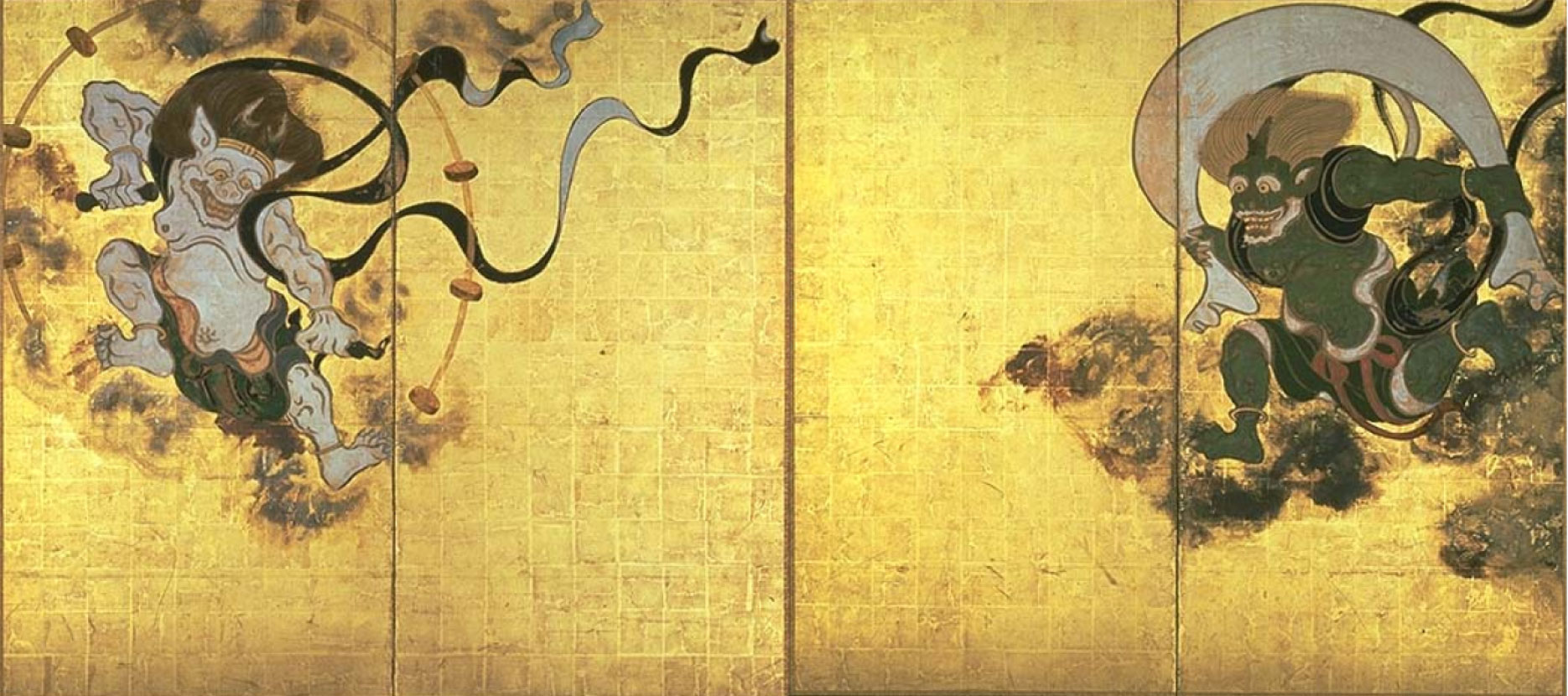
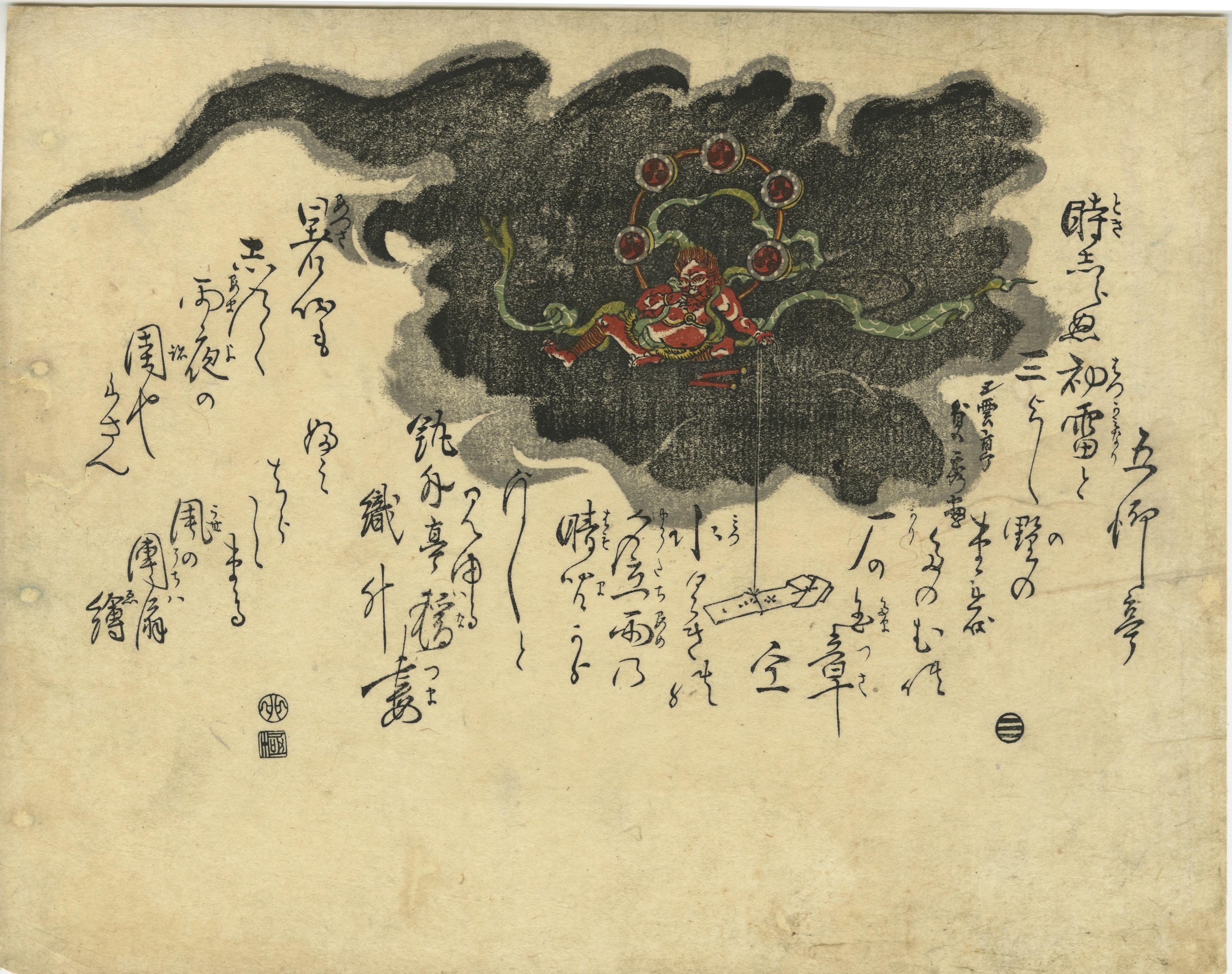
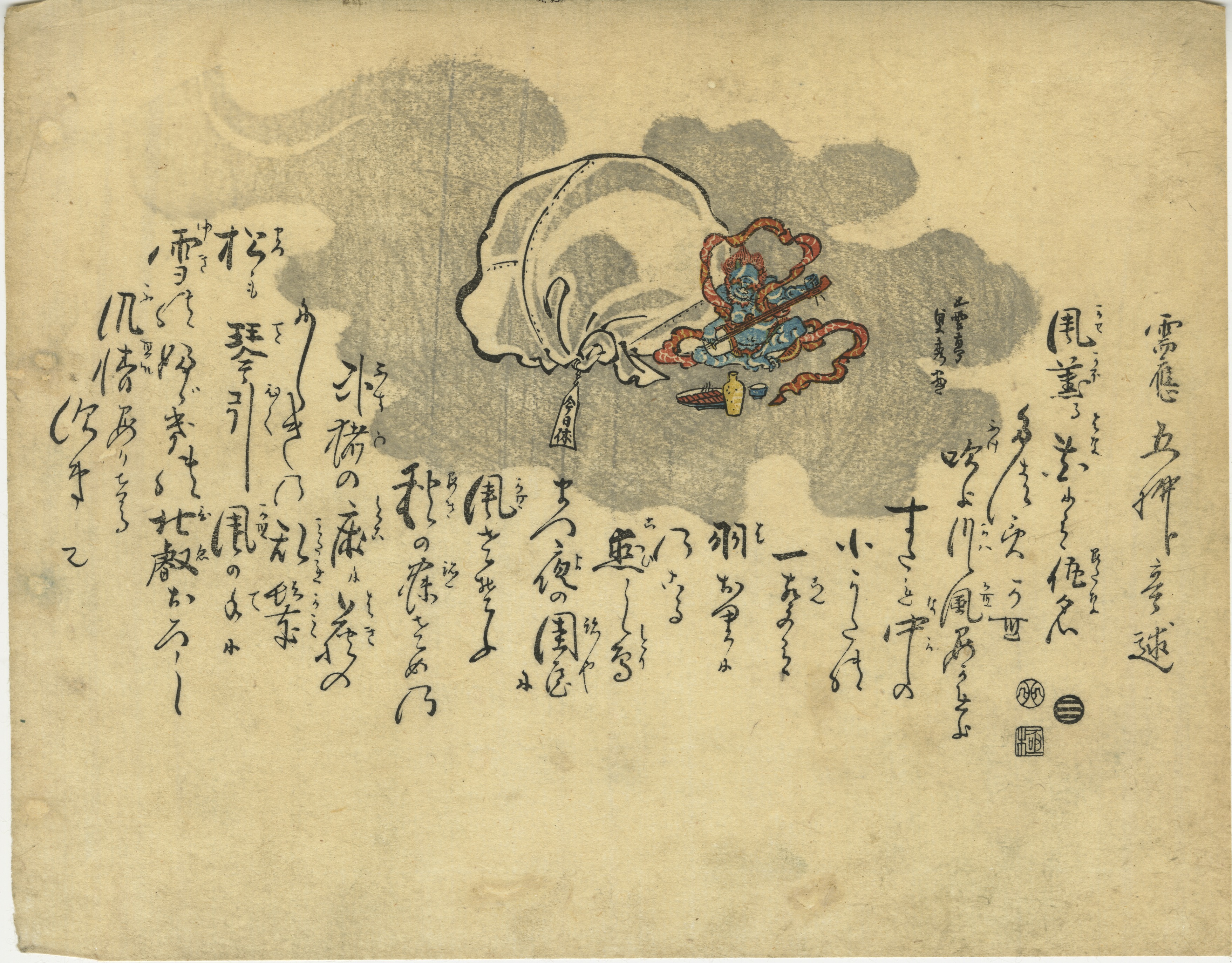
-
 Artist: Utagawa Kuniyoshi [歌川 國芳] (Japanese, 1798 – 1861). Publisher: Ibaya Senzaburō [伊場屋仙三郎] (Japanese, c. 1815 – 1869). Date-aratame seal: 1827 (Bunsei 10). Inscription: Ohan [おはん], Chōemon [長右衛門] | Dainingyō [大人形] | Yoshida Senshi [吉田千四)] | unclear (work in progress). Sam. L. Leiter describes the play in his Kabuki Encyclopedia (1979) p. 183, and Japanese traditional theatre (2014), p. 252 as "Love Suicide of Ohan and Choemon at the Katsura River" (Katsuragawa Renri no Shigarami) [桂川連理柵], a two-act play by Suga Sensuke [菅専助] (ca. 1728 – 1791) written in 1776 for the puppet theatre jūruri and adopted for Osaka kabuki in 1777. Yoshida Senshi, a.k.a. Yoshida Bunzaburo III was a Japanese puppeteer of a Yoshida lineage. The line was established by Yoshida Bunzaburō I [吉田文三郎] (Japanese, fl. 1717 – 1760), who was one of the greatest in the history of Bunraku [人形浄瑠璃] (ningyō jōruri) and who around 1734 introduced the three-man puppet manipulation system. A portrait of Yoshida Senshi, who died in 1829, can be found in the Kunisada's triptych at Jordan Schnitzer Museum of Art, ID Number 2016:37.2.).
Artist: Utagawa Kuniyoshi [歌川 國芳] (Japanese, 1798 – 1861). Publisher: Ibaya Senzaburō [伊場屋仙三郎] (Japanese, c. 1815 – 1869). Date-aratame seal: 1827 (Bunsei 10). Inscription: Ohan [おはん], Chōemon [長右衛門] | Dainingyō [大人形] | Yoshida Senshi [吉田千四)] | unclear (work in progress). Sam. L. Leiter describes the play in his Kabuki Encyclopedia (1979) p. 183, and Japanese traditional theatre (2014), p. 252 as "Love Suicide of Ohan and Choemon at the Katsura River" (Katsuragawa Renri no Shigarami) [桂川連理柵], a two-act play by Suga Sensuke [菅専助] (ca. 1728 – 1791) written in 1776 for the puppet theatre jūruri and adopted for Osaka kabuki in 1777. Yoshida Senshi, a.k.a. Yoshida Bunzaburo III was a Japanese puppeteer of a Yoshida lineage. The line was established by Yoshida Bunzaburō I [吉田文三郎] (Japanese, fl. 1717 – 1760), who was one of the greatest in the history of Bunraku [人形浄瑠璃] (ningyō jōruri) and who around 1734 introduced the three-man puppet manipulation system. A portrait of Yoshida Senshi, who died in 1829, can be found in the Kunisada's triptych at Jordan Schnitzer Museum of Art, ID Number 2016:37.2.). The design on our fan print looks very much like the one of Toyokuni I at MFA (Houston): OBJECT NUMBER 2006.378. "Seki Sanjuro as Obiya Choemon and Ichikawa Denzo as Ohan of the Shinonoya from the Kabuki Drama Katsuragawa renri no shigarami (Love Suicide of Ohan and Choemon at the Katsura River)", according to MFA-H published by someone Tsuruya in c. 1810 (though the publisher's seal is Suzuki Ihei [鈴木伊兵衛] (seal name Suzui [鈴伊]), Marks 01-028 | 502; the censor's seal is gyōji, date 1811-14).
The design on our fan print looks very much like the one of Toyokuni I at MFA (Houston): OBJECT NUMBER 2006.378. "Seki Sanjuro as Obiya Choemon and Ichikawa Denzo as Ohan of the Shinonoya from the Kabuki Drama Katsuragawa renri no shigarami (Love Suicide of Ohan and Choemon at the Katsura River)", according to MFA-H published by someone Tsuruya in c. 1810 (though the publisher's seal is Suzuki Ihei [鈴木伊兵衛] (seal name Suzui [鈴伊]), Marks 01-028 | 502; the censor's seal is gyōji, date 1811-14).
 Interestingly enough, the description provided by Kuniyoshi Project is this "Actors: Onoe Kikugorô III as Shinanoya Ohan (おはん, female) and Ichikawa Ebizô V as Obiya Choemon (長右衛門, male). Play: Go chumon shusu no Obiya (御注文繻子帯屋). Date: 3rd month of 1840. Theater: Kawarasaki. Publisher: Iba-ya Sensaburô".
The play Go chumon shusu no Obiya was indeed staged at Kawarazaki theatre in 1840 (Tenpō 11), 3rd month; Ichikawa Ebizō V was indeed playing Obiya Choemon but Onoe Kikugorō III had the role of Kataoka Kōzaemon, not of Ohan, as can be seen on Kunisada's diptych at MFA (Boston): ACCESSION NUMBER 11.40671a-b.
Interestingly enough, the description provided by Kuniyoshi Project is this "Actors: Onoe Kikugorô III as Shinanoya Ohan (おはん, female) and Ichikawa Ebizô V as Obiya Choemon (長右衛門, male). Play: Go chumon shusu no Obiya (御注文繻子帯屋). Date: 3rd month of 1840. Theater: Kawarasaki. Publisher: Iba-ya Sensaburô".
The play Go chumon shusu no Obiya was indeed staged at Kawarazaki theatre in 1840 (Tenpō 11), 3rd month; Ichikawa Ebizō V was indeed playing Obiya Choemon but Onoe Kikugorō III had the role of Kataoka Kōzaemon, not of Ohan, as can be seen on Kunisada's diptych at MFA (Boston): ACCESSION NUMBER 11.40671a-b.

Actors Ichikawa Ebizô V as Obiya Chôemon (R) and Onoe Kikugorô III as Kataoka Kôzaemon (L)
-
 Artist: Utagawa Kuniyoshi [歌川 國芳] (Japanese, 1798 – 1861). Publisher: Ibaya Senzaburō [伊場屋仙三郎] (Japanese, c. 1815 – 1869). Published in c. 1845 (no seal). Possibly, from the "Untitled series of beauties reflected in mirrors", see Kunisada Project. However, this print does not have the seal of the censor Tanaka [田中].
Artist: Utagawa Kuniyoshi [歌川 國芳] (Japanese, 1798 – 1861). Publisher: Ibaya Senzaburō [伊場屋仙三郎] (Japanese, c. 1815 – 1869). Published in c. 1845 (no seal). Possibly, from the "Untitled series of beauties reflected in mirrors", see Kunisada Project. However, this print does not have the seal of the censor Tanaka [田中]. -
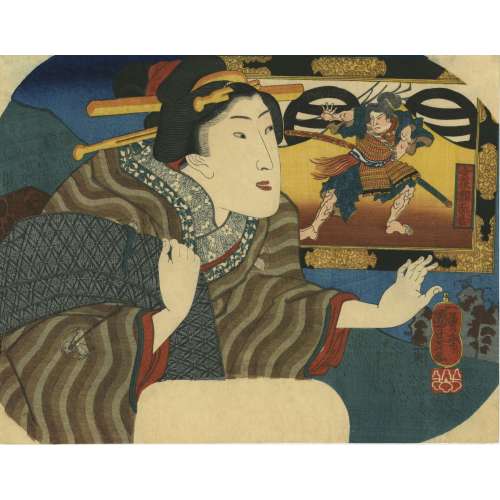 Artist: Utagawa Kuniyoshi [歌川 國芳] (Japanese, 1798 – 1861). Publisher: Izuzen (fl. c. 1800s – 1840s) (Marks 06-029|U103b). Signed: Ichiyosai Kuniyoshi ga in a red cartouche and sealed with paulownia crest (kiri mon). Double nanushi censor seals: Fuku & Muramatsu, 1849-51 (Kaei 2 – Kaei 4). Young woman in front of the western-style framed portrait of Soga Tokimune, who is depicted after having his kusazuri ripped off by Asahina Saburō. The series of fan prints A Collection of Pictures in Modern Style [今様額面合] (Imayô gakumen awase) can be found at Kuniyoshi Project. Soga Tokimune, a.k.a. Soga no Gorō [曾我時致] (Japanese, 1174 – 1193), a historical figure and a character of an epic tale Soga Monogatari [曽我物語] (A Tale of Soga Brothers). Asahina Saburō [朝比奈 三朗], a.k.a. Asahina Yoshihide [朝比奈 義秀] is also mentioned in the Soga Monogatari. Kusazuri [草摺] (くさずり) – tassets on a suit of a samurai's armour. Another Kuniyoshi's print with the same characters: Goro Tokimune and Asahina Saburo; Series: The Tale of Soga Brothers; Publisher: Ibaya Senzaburō; Date: 1843-1845; Size: Vertical Ōban: 359 x 245 mm.
Artist: Utagawa Kuniyoshi [歌川 國芳] (Japanese, 1798 – 1861). Publisher: Izuzen (fl. c. 1800s – 1840s) (Marks 06-029|U103b). Signed: Ichiyosai Kuniyoshi ga in a red cartouche and sealed with paulownia crest (kiri mon). Double nanushi censor seals: Fuku & Muramatsu, 1849-51 (Kaei 2 – Kaei 4). Young woman in front of the western-style framed portrait of Soga Tokimune, who is depicted after having his kusazuri ripped off by Asahina Saburō. The series of fan prints A Collection of Pictures in Modern Style [今様額面合] (Imayô gakumen awase) can be found at Kuniyoshi Project. Soga Tokimune, a.k.a. Soga no Gorō [曾我時致] (Japanese, 1174 – 1193), a historical figure and a character of an epic tale Soga Monogatari [曽我物語] (A Tale of Soga Brothers). Asahina Saburō [朝比奈 三朗], a.k.a. Asahina Yoshihide [朝比奈 義秀] is also mentioned in the Soga Monogatari. Kusazuri [草摺] (くさずり) – tassets on a suit of a samurai's armour. Another Kuniyoshi's print with the same characters: Goro Tokimune and Asahina Saburo; Series: The Tale of Soga Brothers; Publisher: Ibaya Senzaburō; Date: 1843-1845; Size: Vertical Ōban: 359 x 245 mm.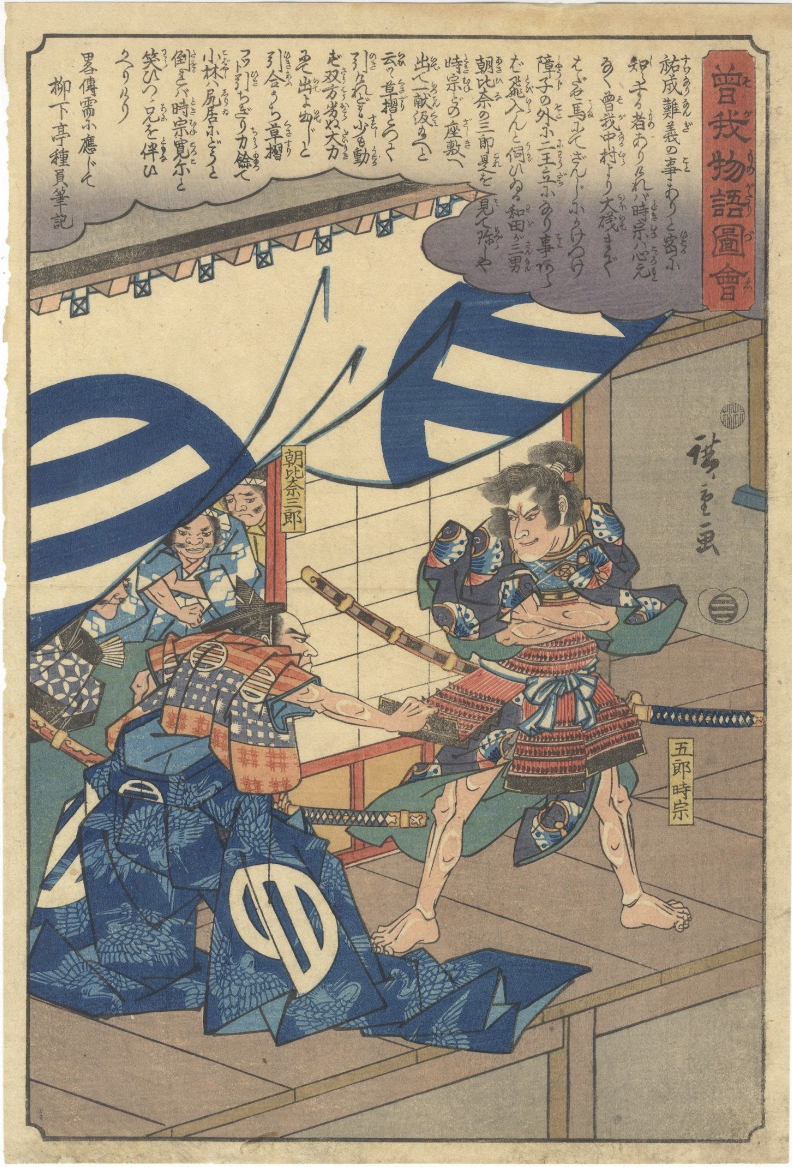
-
 Artist: Utagawa Kuniyoshi [歌川 國芳] (Japanese, 1798 – 1861). Publisher: Enshuya Matabei [遠州屋又兵衛] (Japanese, fl. c. 178 – 1881) – no seal, ref: Kunisada Project. Title: A Summer Evening [夏乃夕暮] (Natsu no Yūgure). A young woman in purple kimono decorated with cranes and waves catching a firefly among yellow and purple flowers. Signed: Ichiyosai Kuniyoshi ga [一勇斎 国芳 画] in a red cartouche and sealed with paulownia (kiri mon). Date seal and double nanushi censor seals: Fuku & Muramatsu, 1853 (Kaei 6, 2nd month). No publisher's seal. Size: Uchiwa-e (untrimmed fan print) 228 x 296 mm. The yellow flower is probably Patrinia scabiosifolia (ominaeshi) [女郎花]. The purple flower seems to be Platycodon grandiflorus or Balloon Flower (kikyō) [桔梗]. Besides, there are visible panicles of Miscanthus sinensis, or Japanese pampas grass (susuki) [薄]. These three are part of the Seven Grasses of Autumn (aki no nanakusa) [秋の七草].
Artist: Utagawa Kuniyoshi [歌川 國芳] (Japanese, 1798 – 1861). Publisher: Enshuya Matabei [遠州屋又兵衛] (Japanese, fl. c. 178 – 1881) – no seal, ref: Kunisada Project. Title: A Summer Evening [夏乃夕暮] (Natsu no Yūgure). A young woman in purple kimono decorated with cranes and waves catching a firefly among yellow and purple flowers. Signed: Ichiyosai Kuniyoshi ga [一勇斎 国芳 画] in a red cartouche and sealed with paulownia (kiri mon). Date seal and double nanushi censor seals: Fuku & Muramatsu, 1853 (Kaei 6, 2nd month). No publisher's seal. Size: Uchiwa-e (untrimmed fan print) 228 x 296 mm. The yellow flower is probably Patrinia scabiosifolia (ominaeshi) [女郎花]. The purple flower seems to be Platycodon grandiflorus or Balloon Flower (kikyō) [桔梗]. Besides, there are visible panicles of Miscanthus sinensis, or Japanese pampas grass (susuki) [薄]. These three are part of the Seven Grasses of Autumn (aki no nanakusa) [秋の七草]. -
 Artist: Utagawa Kunisada [歌川 国貞] a.k.a. Utagawa Toyokuni III [三代歌川豊国] (Japanese, 1786 – 1865). Signed: Ichiyōsai Toyokuni hitsu [一陽斎豊国筆]. Inscriptions: [松竹梅] Shochikubai = pine (matsu, 松), bamboo (take, 竹), and plum (ume, 梅) – an auspicious grouping known as "The Three Friends of Winter"; [三福追] (Sanpuku tsui) – the three delights, or pleasures. Date seal and aratame censor seal: Ansei 2, 1st month (1855). Publisher: Ibaya Senzaburō [伊場屋仙三郎] (Japanese, c. 1815 – 1869). Block carver: Yokokawa Takejirō [横川竹二郎] (Japanese, fl. 1845 – 1863); seal: Hori Take [彫竹]. Kabuki actor Nakamura Shikan IV [中村芝翫] (Nakamura Fukusuke I [中村福助], Nakamura Masanosuke I, Nakamura Komasaburō, Nakamura Tamatarō I, Japanese, 1831 – 1899) arranging a branch of blossoming plum to the memorial portrait of his predecessor Nakamura Utaemon IV [中村歌右衛門] (Nakamura Shikan II, Nakamura Tsurusuke I, Nakamura Tōtarō, Japanese, 1796 – 1852); the latter is dressed in a black robe adorned with a mokkō-crest (mon) of white plum blossom, the hanging scroll border decorated with arabesque and plum blossoms. Actors identified by Horst Graebner. Two fan prints from this series in Varshavsky Collection:
Artist: Utagawa Kunisada [歌川 国貞] a.k.a. Utagawa Toyokuni III [三代歌川豊国] (Japanese, 1786 – 1865). Signed: Ichiyōsai Toyokuni hitsu [一陽斎豊国筆]. Inscriptions: [松竹梅] Shochikubai = pine (matsu, 松), bamboo (take, 竹), and plum (ume, 梅) – an auspicious grouping known as "The Three Friends of Winter"; [三福追] (Sanpuku tsui) – the three delights, or pleasures. Date seal and aratame censor seal: Ansei 2, 1st month (1855). Publisher: Ibaya Senzaburō [伊場屋仙三郎] (Japanese, c. 1815 – 1869). Block carver: Yokokawa Takejirō [横川竹二郎] (Japanese, fl. 1845 – 1863); seal: Hori Take [彫竹]. Kabuki actor Nakamura Shikan IV [中村芝翫] (Nakamura Fukusuke I [中村福助], Nakamura Masanosuke I, Nakamura Komasaburō, Nakamura Tamatarō I, Japanese, 1831 – 1899) arranging a branch of blossoming plum to the memorial portrait of his predecessor Nakamura Utaemon IV [中村歌右衛門] (Nakamura Shikan II, Nakamura Tsurusuke I, Nakamura Tōtarō, Japanese, 1796 – 1852); the latter is dressed in a black robe adorned with a mokkō-crest (mon) of white plum blossom, the hanging scroll border decorated with arabesque and plum blossoms. Actors identified by Horst Graebner. Two fan prints from this series in Varshavsky Collection:
SVJP-0336.2021
-
 Artist: Utagawa Kunisada [歌川 国貞] a.k.a. Utagawa Toyokuni III [三代歌川豊国] (Japanese, 1786 – 1865). Signed: Ichiyōsai Toyokuni hitsu [一陽斎豊国筆]. Inscriptions: [松竹梅] Shochikubai = pine (matsu, 松), bamboo (take, 竹), and plum (ume, 梅) – an auspicious grouping known as “The Three Friends of Winter“; [三福追] (Sanpuku tsui) – the three delights, or pleasures. Date seal and aratame censor seal: Ansei 2, 1st month (1855). Publisher: Ibaya Senzaburō [伊場屋仙三郎] (Japanese, c. 1815 – 1869). Block carver: Yokokawa Takejirō [横川竹二郎] (Japanese, fl. 1845 – 1863); seal: Hori Take [彫竹]. Kabuki actor Onoe Kikugorō V [五代目尾上菊五郎] (Onoe Baikō V, Ichimura Kakitsu IV, Ichimura Uzaemon XIII, Ichimura Kurōemon, Japanese, 1844 – 1903) giving candies to the memorial portrait of his predecessor, Ichimura Takenojō V [市村竹之丞] (Ichimura Uzaemon XII, Ichimura Kamenosuke, Ichimura Toyomatsu, Japanese, 1812 – 1851); the latter is dressed in a green robe adorned with a crest (mon) of a kōrin-style crane in a tortoiseshell (octagon), the hanging scroll border decorated with bamboo under snow; the collar of Onoe's kimono decorated with plum blossoms, another plum blossom arrangement decorates the screen behind him. Actors identified by Horst Graebner. Two fan prints from this series in Varshavsky Collection:
Artist: Utagawa Kunisada [歌川 国貞] a.k.a. Utagawa Toyokuni III [三代歌川豊国] (Japanese, 1786 – 1865). Signed: Ichiyōsai Toyokuni hitsu [一陽斎豊国筆]. Inscriptions: [松竹梅] Shochikubai = pine (matsu, 松), bamboo (take, 竹), and plum (ume, 梅) – an auspicious grouping known as “The Three Friends of Winter“; [三福追] (Sanpuku tsui) – the three delights, or pleasures. Date seal and aratame censor seal: Ansei 2, 1st month (1855). Publisher: Ibaya Senzaburō [伊場屋仙三郎] (Japanese, c. 1815 – 1869). Block carver: Yokokawa Takejirō [横川竹二郎] (Japanese, fl. 1845 – 1863); seal: Hori Take [彫竹]. Kabuki actor Onoe Kikugorō V [五代目尾上菊五郎] (Onoe Baikō V, Ichimura Kakitsu IV, Ichimura Uzaemon XIII, Ichimura Kurōemon, Japanese, 1844 – 1903) giving candies to the memorial portrait of his predecessor, Ichimura Takenojō V [市村竹之丞] (Ichimura Uzaemon XII, Ichimura Kamenosuke, Ichimura Toyomatsu, Japanese, 1812 – 1851); the latter is dressed in a green robe adorned with a crest (mon) of a kōrin-style crane in a tortoiseshell (octagon), the hanging scroll border decorated with bamboo under snow; the collar of Onoe's kimono decorated with plum blossoms, another plum blossom arrangement decorates the screen behind him. Actors identified by Horst Graebner. Two fan prints from this series in Varshavsky Collection:
SVJP-0335.2021
-
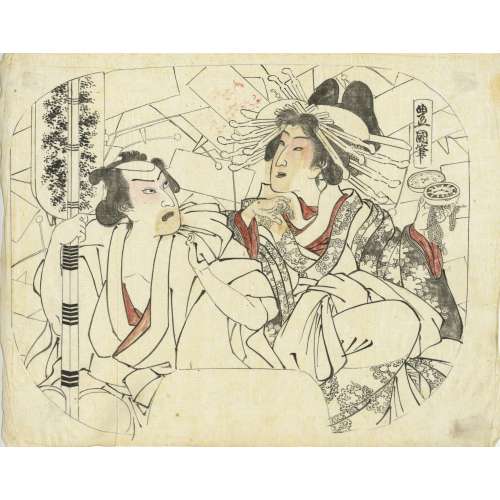 Artist: Horst Graebner positively attributes the drawing to Utagawa Kunisada II [歌川国貞] Japanese, 1823 – 1880) a.k.a. Toyokuni IV, though Israel Goldman attributes it to Utagawa Kunisada [歌川 国貞] (Japanese, 1786 – 1865) a.k.a. Utagawa Toyokuni III. Title: Geisha with a watch / Preparatory drawing for a fan print. Media/Technique: Ink and colour on paper. Signed: Toyokuni hitsu [豊国筆].
Artist: Horst Graebner positively attributes the drawing to Utagawa Kunisada II [歌川国貞] Japanese, 1823 – 1880) a.k.a. Toyokuni IV, though Israel Goldman attributes it to Utagawa Kunisada [歌川 国貞] (Japanese, 1786 – 1865) a.k.a. Utagawa Toyokuni III. Title: Geisha with a watch / Preparatory drawing for a fan print. Media/Technique: Ink and colour on paper. Signed: Toyokuni hitsu [豊国筆]. -
 Artist: Utagawa Kunisada [歌川 国貞] a.k.a. Utagawa Toyokuni III [三代歌川豊国] (Japanese, 1786 – 1865). Signed: Toyokuni ga [豊国 画] in a red toshidama cartouche. Publisher: Ibaya Senzaburō [伊場屋仙三郎] (Japanese, c. 1815 – 1869). Block carver: Yokokawa Takejirō [横川竹二郎] (Japanese, fl. 1845 – 1863); seal Hori Take [彫竹]. Double nanushi censor seals: Mera & Murata (1847-50). Title: Cool Breeze on Tenpōzan Hill in Naniwa [浪花天保山の涼] (Naniwa Tenpōzan no ryō). An uncut fan print (uchiwa-e), depicting a gentleman (most probably kabuki actor Nakamura Utaemon IV) holding a pipe with the view of Tenpōzan Hill [天保山] in Naniwa (Osaka) in the background. A distinctive structure on the left is the Sumiyoshi Lantern [住吉高灯篭] (Sumiyoshi takadōrō), which was destroyed by a typhoon in 1950. The character 翫 – moteasobu – on the gentleman’s robe means "take pleasure, play an instrument". Nakamura Utaemon IV [中村歌右衛門] (Japanese, 1796 – 1852); other names: Nakamura Shikan II, Nakamura Tsurusuke I, Nakamura Tōtarō. The character is visually similar to a gentleman drinking tea on a veranda under the shining moon from the series ‘Moon, Sun, Stars’ [月日星] (Getsu hi hoshi), see SVJP-0211-1.2016: The Moon.
Artist: Utagawa Kunisada [歌川 国貞] a.k.a. Utagawa Toyokuni III [三代歌川豊国] (Japanese, 1786 – 1865). Signed: Toyokuni ga [豊国 画] in a red toshidama cartouche. Publisher: Ibaya Senzaburō [伊場屋仙三郎] (Japanese, c. 1815 – 1869). Block carver: Yokokawa Takejirō [横川竹二郎] (Japanese, fl. 1845 – 1863); seal Hori Take [彫竹]. Double nanushi censor seals: Mera & Murata (1847-50). Title: Cool Breeze on Tenpōzan Hill in Naniwa [浪花天保山の涼] (Naniwa Tenpōzan no ryō). An uncut fan print (uchiwa-e), depicting a gentleman (most probably kabuki actor Nakamura Utaemon IV) holding a pipe with the view of Tenpōzan Hill [天保山] in Naniwa (Osaka) in the background. A distinctive structure on the left is the Sumiyoshi Lantern [住吉高灯篭] (Sumiyoshi takadōrō), which was destroyed by a typhoon in 1950. The character 翫 – moteasobu – on the gentleman’s robe means "take pleasure, play an instrument". Nakamura Utaemon IV [中村歌右衛門] (Japanese, 1796 – 1852); other names: Nakamura Shikan II, Nakamura Tsurusuke I, Nakamura Tōtarō. The character is visually similar to a gentleman drinking tea on a veranda under the shining moon from the series ‘Moon, Sun, Stars’ [月日星] (Getsu hi hoshi), see SVJP-0211-1.2016: The Moon. As noted by Horst Graebner, the gentleman also resembles the character on another Kunisada's actor print, published in 1852 (Waseda University Cultural Resources Database № 114-0232):
As noted by Horst Graebner, the gentleman also resembles the character on another Kunisada's actor print, published in 1852 (Waseda University Cultural Resources Database № 114-0232):

-
 Utagawa Kunisada [歌川 国貞]; a.k.a. Utagawa Toyokuni III [三代歌川豊国] (Japanese, 1786 – 1865). Signed: Toyokuni ga [豊国 画] in a yellow toshidama cartouche. Publisher: Unknown, seal [久] Kyū (Japanese, fl. c. 1851 – 1861); (Marks 07-023 | U176a, possibly Sagamia Kyūzō). Date seal and double nanushi censor seals: Fuku & Muramatsu, Kaei 6, 2nd month (2/1853). Inscription in a red cartouche: (Purple of Edo // Purple of the Bay Capital) [江都むらさき] (Edo Murasaki), alluding to Murasaki Shikibu [紫 式部] (Japanese, c. 973/8 – c. 1014/31), the author of Genji Monogatari [源氏物語] (The Tale of Genji), a Heian period novel which was the source of a parody Nise Murasaki Inaka Genji [偐紫田舎源氏] (Fake Murasaki’s Rustic Genji) by Ryutei Tanehiko [柳亭種彦] (Japanese, 1783 – 1842). According to Horst Graebner: The actor is Ichikawa Danjūrō VIII. Ichikawa Danjūrō VIII [市川団十郎] (Japanese, 1823 – 1854); other names: Ichikawa Ebizō VI, Ichikawa Shinnosuke II. One of the series of Kunisada’s fan prints in this collection:
Utagawa Kunisada [歌川 国貞]; a.k.a. Utagawa Toyokuni III [三代歌川豊国] (Japanese, 1786 – 1865). Signed: Toyokuni ga [豊国 画] in a yellow toshidama cartouche. Publisher: Unknown, seal [久] Kyū (Japanese, fl. c. 1851 – 1861); (Marks 07-023 | U176a, possibly Sagamia Kyūzō). Date seal and double nanushi censor seals: Fuku & Muramatsu, Kaei 6, 2nd month (2/1853). Inscription in a red cartouche: (Purple of Edo // Purple of the Bay Capital) [江都むらさき] (Edo Murasaki), alluding to Murasaki Shikibu [紫 式部] (Japanese, c. 973/8 – c. 1014/31), the author of Genji Monogatari [源氏物語] (The Tale of Genji), a Heian period novel which was the source of a parody Nise Murasaki Inaka Genji [偐紫田舎源氏] (Fake Murasaki’s Rustic Genji) by Ryutei Tanehiko [柳亭種彦] (Japanese, 1783 – 1842). According to Horst Graebner: The actor is Ichikawa Danjūrō VIII. Ichikawa Danjūrō VIII [市川団十郎] (Japanese, 1823 – 1854); other names: Ichikawa Ebizō VI, Ichikawa Shinnosuke II. One of the series of Kunisada’s fan prints in this collection: -
 Utagawa Kunisada [歌川 国貞] a.k.a. Utagawa Toyokuni III [三代歌川豊国] (Japanese, 1786 – 1865). Signed: Toyokuni ga [豊国 画] in a yellow toshidama cartouche. Publisher: Unknown, seal [久] Kyū (Japanese, fl. c. 1851 – 1861); (Marks 07-023 | U176a, possibly Sagamia Kyūzō). Block carver: Koizumi Minokichi [小泉巳の吉] (Japanese, 1833 – 1906); seal: Hori Mino [彫已の] (Gordon Friese № 38). Date seal and double nanushi censor seals: Fuku & Muramatsu, Kaei 6, 2nd month (2/1853). Inscription in a red cartouche: (Purple of Edo // Purple of the Bay Capital) [江都むらさき] (Edo Murasaki), alluding to Murasaki Shikibu [紫 式部] (Japanese, c. 973/8 – c. 1014/31), the author of Genji Monogatari [源氏物語] (The Tale of Genji), a Heian period novel which was the source of a parody Nise Murasaki Inaka Genji [偐紫田舎源氏] (Fake Murasaki’s Rustic Genji) by Ryutei Tanehiko [柳亭種彦] (Japanese, 1783 – 1842). According to Horst Graebner: The actor is most probably Segawa Kikunojō V. Segawa Kikunojō V [瀬川菊之丞] (Japanese, 1802 – 1832); other names: Segawa Tamon I. One of the series of Kunisada's fan prints in this collection:
Utagawa Kunisada [歌川 国貞] a.k.a. Utagawa Toyokuni III [三代歌川豊国] (Japanese, 1786 – 1865). Signed: Toyokuni ga [豊国 画] in a yellow toshidama cartouche. Publisher: Unknown, seal [久] Kyū (Japanese, fl. c. 1851 – 1861); (Marks 07-023 | U176a, possibly Sagamia Kyūzō). Block carver: Koizumi Minokichi [小泉巳の吉] (Japanese, 1833 – 1906); seal: Hori Mino [彫已の] (Gordon Friese № 38). Date seal and double nanushi censor seals: Fuku & Muramatsu, Kaei 6, 2nd month (2/1853). Inscription in a red cartouche: (Purple of Edo // Purple of the Bay Capital) [江都むらさき] (Edo Murasaki), alluding to Murasaki Shikibu [紫 式部] (Japanese, c. 973/8 – c. 1014/31), the author of Genji Monogatari [源氏物語] (The Tale of Genji), a Heian period novel which was the source of a parody Nise Murasaki Inaka Genji [偐紫田舎源氏] (Fake Murasaki’s Rustic Genji) by Ryutei Tanehiko [柳亭種彦] (Japanese, 1783 – 1842). According to Horst Graebner: The actor is most probably Segawa Kikunojō V. Segawa Kikunojō V [瀬川菊之丞] (Japanese, 1802 – 1832); other names: Segawa Tamon I. One of the series of Kunisada's fan prints in this collection: -
 Artist: Utagawa Kunisada [歌川 国貞] a.k.a. Utagawa Toyokuni III [三代歌川豊国] (Japanese, 1786 – 1865). Signed: Ōju Toyokuni ga [応需豊国画], in a toshidama cartouche. Double nanushi censor seals Mera & Murata (1846-50). Publisher: Kojimaya Jūbei [小嶋屋重兵衛] (Japanese, fl. c. 1797 – 1869). Kabuki actor Ichikawa Danjūrō VIII [市川団十郎] (Ichikawa Ebizō VI, Ichikawa Shinnosuke II, Japanese, 1823 – 1854) watches the sunrise over Mount Fuji. The complete set of series Moon, Sun, Stars [月日星] (tsuki-hi-hoshi/boshi), three sources of light (sankō) [三光]:
Artist: Utagawa Kunisada [歌川 国貞] a.k.a. Utagawa Toyokuni III [三代歌川豊国] (Japanese, 1786 – 1865). Signed: Ōju Toyokuni ga [応需豊国画], in a toshidama cartouche. Double nanushi censor seals Mera & Murata (1846-50). Publisher: Kojimaya Jūbei [小嶋屋重兵衛] (Japanese, fl. c. 1797 – 1869). Kabuki actor Ichikawa Danjūrō VIII [市川団十郎] (Ichikawa Ebizō VI, Ichikawa Shinnosuke II, Japanese, 1823 – 1854) watches the sunrise over Mount Fuji. The complete set of series Moon, Sun, Stars [月日星] (tsuki-hi-hoshi/boshi), three sources of light (sankō) [三光]: -
 Artist: Utagawa Kunisada [歌川 国貞] a.k.a. Utagawa Toyokuni III [三代歌川豊国] (Japanese, 1786 – 1865). Signed: Ōju Toyokuni ga [応需豊国画] in a toshidama cartouche. Double nanushi censor seals Mera & Murata (1846-50). Publisher: Kojimaya Jūbei [小嶋屋重兵衛] (Japanese, fl. c. 1797 – 1869). A gentleman, probably a kabuki actor Nakamura Utaemon IV [中村歌右衛門] (Nakamura Shikan II, Nakamura Tsurusuke I, Nakamura Tōtarō, Japanese, 1796 – 1852) drinking tea on a veranda under the shining moon. Series Moon, Sun, Stars [月日星] (tsuki-hi-hoshi/boshi), the three sources of light (sankō) [三光]:
Artist: Utagawa Kunisada [歌川 国貞] a.k.a. Utagawa Toyokuni III [三代歌川豊国] (Japanese, 1786 – 1865). Signed: Ōju Toyokuni ga [応需豊国画] in a toshidama cartouche. Double nanushi censor seals Mera & Murata (1846-50). Publisher: Kojimaya Jūbei [小嶋屋重兵衛] (Japanese, fl. c. 1797 – 1869). A gentleman, probably a kabuki actor Nakamura Utaemon IV [中村歌右衛門] (Nakamura Shikan II, Nakamura Tsurusuke I, Nakamura Tōtarō, Japanese, 1796 – 1852) drinking tea on a veranda under the shining moon. Series Moon, Sun, Stars [月日星] (tsuki-hi-hoshi/boshi), the three sources of light (sankō) [三光]: -
 Artist: Utagawa Kunisada [歌川 国貞] a.k.a. Utagawa Toyokuni III [三代歌川豊国] (Japanese, 1786 – 1865). Signed: Kōchō(rō) Kunisada ga (香蝶国貞画) in a red double-gourd cartouche. Publisher: Surugaya Sakujirō [駿河屋作次郎] (Japanese, fl. c. 1844 – 1865); Marks 06-005 | 501a. Single nanushi censor seal: Muramatsu (1843-6). The date is attributed to c. 1844. Title: Narihira [なり平]. Ariwara no Narihira [在原 業平] (Japanese, 825 – 880) – one of the Six Immortal Poets – The Rokkasen [六歌仙]. Series: A parody of six immortal poets [見立六花撰] (Mitate Rokkasen). Media: Untrimmed fan print (uchiwa-e), 227 x 293 mm, depicting a beautiful woman with a bow and arrows in her left hand. Series: Mitate Rokkasen [見立六花撰] – is sometimes interpreted as "A parody of six immortal poets" or "A comparison of six select flowers". [LIB-1212.2017] Robert Schaap. Kunisada: Imaging, drama and beauty. — Leiden: Hotei Publishing, 2016; pl. 28, p. 58. This is another fan print with another immortal poet, Bun'ya no Yasuhide [文屋 康秀] (Japanese, -d. 885?), from the same series, provided in the book:With special thanks to Horst Graebner for help with the description and date attribution: "The print can be dated to 1844: censor seal is Muramatsu (Muramatsu Genroku); he acted in 7/1844 and 4/1845 (and also later) as censor but Kunisada changed his name to Kunisada early in 1844."
Artist: Utagawa Kunisada [歌川 国貞] a.k.a. Utagawa Toyokuni III [三代歌川豊国] (Japanese, 1786 – 1865). Signed: Kōchō(rō) Kunisada ga (香蝶国貞画) in a red double-gourd cartouche. Publisher: Surugaya Sakujirō [駿河屋作次郎] (Japanese, fl. c. 1844 – 1865); Marks 06-005 | 501a. Single nanushi censor seal: Muramatsu (1843-6). The date is attributed to c. 1844. Title: Narihira [なり平]. Ariwara no Narihira [在原 業平] (Japanese, 825 – 880) – one of the Six Immortal Poets – The Rokkasen [六歌仙]. Series: A parody of six immortal poets [見立六花撰] (Mitate Rokkasen). Media: Untrimmed fan print (uchiwa-e), 227 x 293 mm, depicting a beautiful woman with a bow and arrows in her left hand. Series: Mitate Rokkasen [見立六花撰] – is sometimes interpreted as "A parody of six immortal poets" or "A comparison of six select flowers". [LIB-1212.2017] Robert Schaap. Kunisada: Imaging, drama and beauty. — Leiden: Hotei Publishing, 2016; pl. 28, p. 58. This is another fan print with another immortal poet, Bun'ya no Yasuhide [文屋 康秀] (Japanese, -d. 885?), from the same series, provided in the book:With special thanks to Horst Graebner for help with the description and date attribution: "The print can be dated to 1844: censor seal is Muramatsu (Muramatsu Genroku); he acted in 7/1844 and 4/1845 (and also later) as censor but Kunisada changed his name to Kunisada early in 1844."
Robert Schaap, 2016.
-
 Artist: Utagawa Kunisada [歌川 国貞] a.k.a. Utagawa Toyokuni III [三代歌川豊国] (Japanese, 1786 – 1865). Signed: Kochoro Kuisada ga [香蝶楼国貞画] in a red double-gourd cartouche Publisher: Enshūya Matabei [遠州屋又兵衛] (Japanese, fl. c. 1768 – 1881). Series: Fashionable Youths [流行若手揃] (Ryuko Wakate Zoroi). Actor: Bandō Minosuke II [坂東蓑助] (Japanese, 1802 – 1863); other names: Morita Kan'ya XI, Bandô Mitsugorō IV. Date-kiwame seals: Bunsei 13 / Tenpō 1 (1830). One more print from the same series (See Waseda 201-2125); not in this collection: Segawa Kikunojō V [瀬川菊之丞] (Japanese, 1802 – 1832); other names: Segawa Tamon I.
Artist: Utagawa Kunisada [歌川 国貞] a.k.a. Utagawa Toyokuni III [三代歌川豊国] (Japanese, 1786 – 1865). Signed: Kochoro Kuisada ga [香蝶楼国貞画] in a red double-gourd cartouche Publisher: Enshūya Matabei [遠州屋又兵衛] (Japanese, fl. c. 1768 – 1881). Series: Fashionable Youths [流行若手揃] (Ryuko Wakate Zoroi). Actor: Bandō Minosuke II [坂東蓑助] (Japanese, 1802 – 1863); other names: Morita Kan'ya XI, Bandô Mitsugorō IV. Date-kiwame seals: Bunsei 13 / Tenpō 1 (1830). One more print from the same series (See Waseda 201-2125); not in this collection: Segawa Kikunojō V [瀬川菊之丞] (Japanese, 1802 – 1832); other names: Segawa Tamon I.
-
 Artist: Utagawa Kunisada [歌川 国貞] a.k.a. Utagawa Toyokuni III [三代歌川豊国] (Japanese, 1786 – 1865). Publisher: Ibaya Senzaburō [伊場屋仙三郎] (Japanese, fl. C. 1845 – 1847). Date seal: [子五] Kaei 5, 5th month (5/1852). Signed: Toyokuni ga [豊国 画] in a red toshidama cartouche. Title: Actor Bandō Takesaburō I as clerk Seijūrō [手代清十郎] (left) and Actor Ichikawa Kodanji IV as Kenkaya Gorōkichi [喧嘩屋五郎吉] (right) in the play Musume ōgi tsui no tatehiki [娘扇一対侠贔屓 (むすめおうぎついのたてひき)] performed at the Nakamura theatre [中村座], in Edo (Tokyo). The playbill for this performance can be found at MFA (Boston) # 11.28042, 11.28285, 11.28286:
Artist: Utagawa Kunisada [歌川 国貞] a.k.a. Utagawa Toyokuni III [三代歌川豊国] (Japanese, 1786 – 1865). Publisher: Ibaya Senzaburō [伊場屋仙三郎] (Japanese, fl. C. 1845 – 1847). Date seal: [子五] Kaei 5, 5th month (5/1852). Signed: Toyokuni ga [豊国 画] in a red toshidama cartouche. Title: Actor Bandō Takesaburō I as clerk Seijūrō [手代清十郎] (left) and Actor Ichikawa Kodanji IV as Kenkaya Gorōkichi [喧嘩屋五郎吉] (right) in the play Musume ōgi tsui no tatehiki [娘扇一対侠贔屓 (むすめおうぎついのたてひき)] performed at the Nakamura theatre [中村座], in Edo (Tokyo). The playbill for this performance can be found at MFA (Boston) # 11.28042, 11.28285, 11.28286: Actors:
Bandō Takesaburō I (初代坂東竹三郎) (Japanese, 1832 – 1877); other names: Shinshi, Shinsui V, Bandō Hikosaburō V [五代目坂東彦三郎], Bandō Tsurunosuke I.
Ichikawa Kodanji IV [市川小團次] (Japanese, 1812 – 1866); other names: Ichikawa Yonejūrō I, Ichikawa Yonezō III, Ichikawa Eizō.
Actors:
Bandō Takesaburō I (初代坂東竹三郎) (Japanese, 1832 – 1877); other names: Shinshi, Shinsui V, Bandō Hikosaburō V [五代目坂東彦三郎], Bandō Tsurunosuke I.
Ichikawa Kodanji IV [市川小團次] (Japanese, 1812 – 1866); other names: Ichikawa Yonejūrō I, Ichikawa Yonezō III, Ichikawa Eizō.
Similar images were then used for the series Seven flourishing plants on lanterns for summer evenings [涼調珍盛の七草] (Suzumi chōchin sakari no nanakusa) published by Ibaya Senzaburō in 1852 (Kaei 5), 6th month.

Bandō Takesaburō I (carved by Yokokawa Takejirō): https://collections.mfa.org/objects/219360

Actor Ichikawa Kodanji IV (carved by Nakamura Tōkichi): https://collections.mfa.org/objects/477146.









